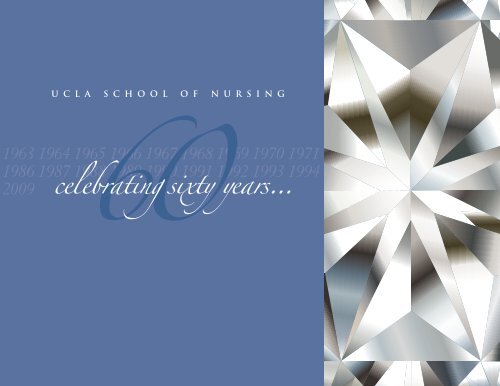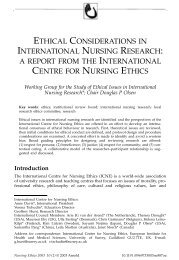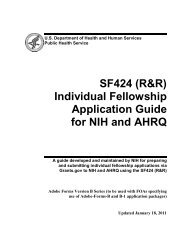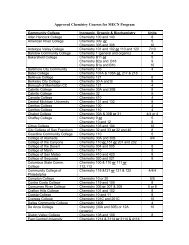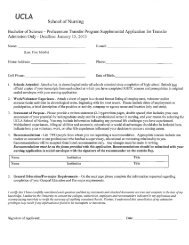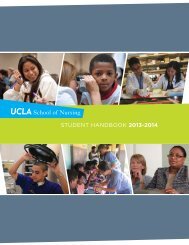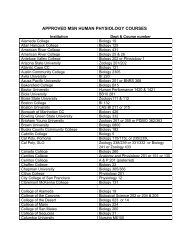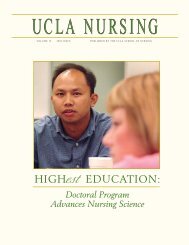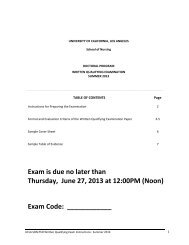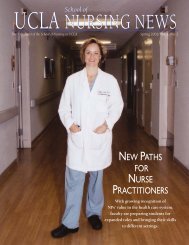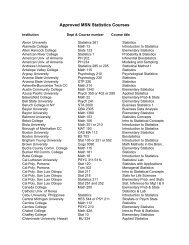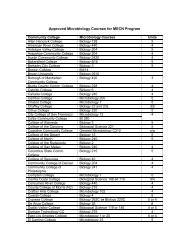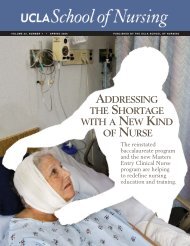EMBARKING ON A NEW ERA - UCLA School of Nursing
EMBARKING ON A NEW ERA - UCLA School of Nursing
EMBARKING ON A NEW ERA - UCLA School of Nursing
- No tags were found...
You also want an ePaper? Increase the reach of your titles
YUMPU automatically turns print PDFs into web optimized ePapers that Google loves.
U C L A S C H O O L O F N U R S I N G1963 1964 1965 1966 1967 1968 1969 1970 19711986 1987 1988601989 1990 1991 1992 1993 19942009 celebrating sixty years......and<strong>EMBARKING</strong><strong>ON</strong> A<strong>NEW</strong> <strong>ERA</strong>
U C L A S C H O O L O F N U R S I N G1963 1964 1965 1966 1967 1968 1969 1970 19711986 1987 1988601989 1990 1991 1992 1993 19942009 celebrating sixty years......and<strong>EMBARKING</strong><strong>ON</strong> A<strong>NEW</strong> <strong>ERA</strong>
NURSINGschool <strong>of</strong>T R A N S F O R M I N G N U R S I N G S C I E N C Einside...60 Alumni Who HaveMade a DifferenceA <strong>School</strong> Well Positionedto Pave the Way for thePr<strong>of</strong>ession in the Next 60
LETTER FROM THE DEANThe traditional symbol for a 60th anniversaryis the diamond. As we celebratethe 60th anniversary <strong>of</strong> the founding<strong>of</strong> the <strong>UCLA</strong> <strong>School</strong> <strong>of</strong> <strong>Nursing</strong>,I’m struck by just how apropos that symbol is.Diamond comes from the Greek word adamas, which means unconquerable and enduring. This certainlyapplies to the <strong>School</strong> <strong>of</strong> <strong>Nursing</strong> as we reflect on the last six decades. The school has faced significant challengesat many points over its 60-year history, but has proved unconquerable in overcoming each one <strong>of</strong>them. There is no doubt that we have endured. But far more than enduring, we have always emerged fromthese challenges stronger and better equipped to build on our legacy as educators, researchers, and providers<strong>of</strong> community service.Our history is one that should fill each <strong>of</strong> us with pride. In the 60 years since being <strong>of</strong>ficiallyestablished in 1949, our school has led the way as nursing education has shifted from the hospital to theuniversity, as the science <strong>of</strong> nursing has come <strong>of</strong> age, and as advanced practice nurses have carved a niche asinvaluable players in the healthcare arena.Our pioneering spirit dates back to the school’s founding dean, Lulu Wolf Hassenplug, who told University<strong>of</strong> California administrators that a condition <strong>of</strong> her accepting their <strong>of</strong>fer was that the new school bea university-based program for baccalaureate and master’s preparation. At a time when nursing studentswere <strong>of</strong>ten treated as hired help for hospitals, this represented a new model, with students integrated intothe university.Dean Hassenplug did things her way, even when it ruffled establishment feathers. Early on she decidedthat her students wouldn’t be required to wear the traditional nursing caps during their clinical rotations.Instead <strong>of</strong> being identified by their apparel, she explained, her students would be identified by what they did.The symbolism, at a time when nursing was finally being recognized as a pr<strong>of</strong>ession, was unavoidable.
But this wasn’t just about symbolism. From the start, the school established innovative curricula thatwere used as models by other nursing schools in the United States and abroad. Some <strong>of</strong> the most widelyadopted theory-based patient care models were developed, tested and utilized at our school in the late 1960sand early 1970s. Our faculty helped to pioneer the new role <strong>of</strong> the nurse practitioner beginning in the early1970s and continuing through the 1990s with the establishment <strong>of</strong> the West Coast’s first acute care nurse practitionerprogram. The school has always had a strong foundation in science – in the early years, faculty wereamong the first to conduct research on nursing interventions and outcomes – but the research enterprisehas grown dramatically in the last two-plus decades with the establishment <strong>of</strong> our doctoral program and therecruitment <strong>of</strong> some <strong>of</strong> the most renowned scientists to our faculty.Our school’s history <strong>of</strong> making a difference isn’t confined to the important research findings that havechanged patient care, nor is it limited to the graduates who continue to transform nursing practice andscience – 60 <strong>of</strong> whom are featured in this issue. We are also a school with a rich history <strong>of</strong> diversity amongour students, and a school with an unrivaled track record when it comes to addressing the needs <strong>of</strong> society’smost vulnerable members, whether it’s through the community-based participatory research <strong>of</strong> our facultyin underserved communities or the nurse-managed clinics that we run. Most notable among the latter is the<strong>UCLA</strong> <strong>School</strong> <strong>of</strong> <strong>Nursing</strong> Health Clinic at the Union Rescue Mission in Los Angeles’s Skid Row area, whichhas been in operation since 1983 and currently receives more than 8,000 visits from homeless and indigentpatients each year.At several points in our history we have dealt with financial and budgetary crises, but with the help <strong>of</strong>our alumni and friends we have always overcome them. Today, even as we face the formidable economicchallenges confronting the entire University <strong>of</strong> California system, we continue to thrive. Our student populationhas doubled in the last three years alone. Our faculty continues to expand on the practice <strong>of</strong> nursingscience, building a wide-ranging research enterprise that is developing potential solutions to the most importanthealth challenges <strong>of</strong> the day, from improving the health <strong>of</strong> our most vulnerable groups to addressingissues related to wound care, Alzheimer’s disease and other illnesses <strong>of</strong> our aging population.Indeed, while there is so much to be proud <strong>of</strong>, what we are really celebrating as we turn 60 is the outlookfor our future. The possibilities for the coming years are boundless; our vision is expansive.Research: In the last year, funding for research grants at our school has tripled – from $6 million to approximately$18 million. Every day, nurses see the challenges faced by the individuals to whom they providecare. From the laboratory bench to the patient’s bedside, our faculty scholars are using the science <strong>of</strong> nursingto solve real-world problems and improve the delivery <strong>of</strong> care. They are improving prevention efforts
for the homeless at risk <strong>of</strong> hepatitis and HIV viruses; improving the quality <strong>of</strong> pressure ulcer care in nursinghomes; determining if high-protein diets will reduce the incidence <strong>of</strong> heart failure; assessing the relationship<strong>of</strong> brain activity and sleep apnea to cardiovascular health; and examining addiction in chronic painpatients. These are but a few <strong>of</strong> the major initiatives currently being funded.Education: While our student enrollment has more than doubled in the last four years, it is still notenough given the critical nursing shortage that will occur in the next decade, as nurses retire and the agingbaby boom population increases the demand for healthcare services. We need not only to expand ourability to train more nurses, but also to produce more teachers to train the nurses. Our Center for theAdvancement <strong>of</strong> Gerontological <strong>Nursing</strong> Science in particular is emphasizing the recruitment <strong>of</strong> practicingnurses who return to school, obtain a doctorate focused on aging and then teach nurses how to care for ourelder population.Community Service: While we already provide healthcare to the underserved through our clinic at theUnion Rescue Mission, we are looking for other ways to expand our relationships within the community andexpand culturally competent healthcare services. Several <strong>of</strong> our faculty recently received grants to look atways to improve care for African Americans and Latinos here in Los Angeles.Global Outreach: The World Health Organization is also marking its 60th anniversary – and in muchthe same way as the <strong>UCLA</strong> <strong>School</strong> <strong>of</strong> <strong>Nursing</strong>. While the WHO highlights its achievements <strong>of</strong> the last60 years, it is addressing the challenges <strong>of</strong> the future. We are developing international/global initiatives thatwill allow us to expand our education and training to provide students with the opportunity to learn nursingfrom a culturally competent perspective. Global outreach will facilitate student exchange, researchexperiences and resource sharing.At the <strong>UCLA</strong> <strong>School</strong> <strong>of</strong> <strong>Nursing</strong> we celebrate a 60-year record <strong>of</strong> achievement at a time when we arepoised to accomplish even greater things in the years ahead. We live in an era in which our contributions havenever been more vital to the population’s health. Nurses are the faces <strong>of</strong> the future. And the best nurses – inresearch, education and clinical practice – will be <strong>UCLA</strong> nurses.COURTNEY H. LYDER, N.D., G.N.P., F.A.A.N.Dean and Pr<strong>of</strong>essor, <strong>School</strong> <strong>of</strong> <strong>Nursing</strong>Assistant Director for Academic <strong>Nursing</strong>,<strong>UCLA</strong> Health System
SIXTY WHOHAVE MADE ADIFFERENCEOver its 60-year history, the <strong>UCLA</strong> <strong>School</strong> <strong>of</strong> <strong>Nursing</strong>has graduated numerous individuals who have madesignificant contributions to – and in many cases, transformed –clinical practice, science, education, and health policy.Here are 60 alumni who exemplify the outstanding caliberassociated with a <strong>UCLA</strong> <strong>School</strong> <strong>of</strong> <strong>Nursing</strong> degree.
1950SRoberta J. Gerds (Langton), B.S. ’54, M.N. ’77Gerds was a pre-nursing student at <strong>UCLA</strong> when the<strong>School</strong> <strong>of</strong> <strong>Nursing</strong> began to admit students to the newbaccalaureate program; more than two decades after shegraduated, she returned to the school and earned hermaster’s degree in 1977. During her career Gerdsworked in staff nursing (mainly in maternity/labor and delivery settings), public health nursing andteaching. She was a childbirth educator who taughttraining classes for other childbirth educators and wasactive in the Childbirth Education Association. Gerds’teaching career included 18 years at California StateUniversity, Bakersfield, from which she retired in 2000.She was active in the community, working with the Maternal,Child and Adolescent Health Council <strong>of</strong> KernCounty, the Breastfeeding Promotion Coalition,Healthy Mothers, Healthy Babies <strong>of</strong> Kern County, andthe KCEOC Health Advisory Council. In retirementGerds has been working with members <strong>of</strong> her church toassist people in the congregation who need help in managinghealthcare needs.1950Ann Larae Ivey, B.S. ’57, M.S. ’64After earning her B.S. as part <strong>of</strong> the school’s fourthgraduating class, Ivey became a public health nurse forthe City <strong>of</strong> San Bernardino. With five years <strong>of</strong> experience,she returned to <strong>UCLA</strong> and earned an M.S. in<strong>Nursing</strong> Administration. Ivey then went back to theSan Bernardino County Health Department as a supervisingpublic health nurse and progressed throughpositions <strong>of</strong> increasing responsibility until she becamechief <strong>of</strong> community health services, a position she heldfor 10 years. In that role, Ivey worked actively to solvethe problems <strong>of</strong> the community by collaborating withand leading communities in addressing issues <strong>of</strong> childrenat risk, homelessness, hearing impairment, ethics,teen pregnancy, and healthcare reform. In 1999, Iveywas involved in the planning and implementation <strong>of</strong> aMasters in <strong>Nursing</strong> program at California State UniversitySan Bernardino; she was a consultant for theprogram from 1999 until her death in 2008. Ivey alsoserved as an associate clinical pr<strong>of</strong>essor at Loma LindaUniversity <strong>School</strong> <strong>of</strong> <strong>Nursing</strong> for 25 years and as a lecturerat the <strong>UCLA</strong> <strong>School</strong> <strong>of</strong> <strong>Nursing</strong>.Rose Marie Nesbit, B.S. ’57Having graduated from the school with highest honors,Nesbit went on to work as a public health nurse for theLos Angeles County Health Department in Inglewood,and later at the Santa Monica Health Center assistingthe assistant district health <strong>of</strong>ficer in providing immunizationsfor parochial school children throughout LosAngeles County. Well after Nesbit’s formal nursing careerended, she has continued to promote the pr<strong>of</strong>essionthrough her support <strong>of</strong> the school. Nesbit was chair <strong>of</strong>the Board <strong>of</strong> Advisors under Dean Ada Lindsey andDean Marie Cowan. With her husband, Dr. RichardNesbit, she was active on a committee that successfullyraised funds to establish the Lulu Wolf Hassenplug EndowedChair in honor <strong>of</strong> the school’s founding dean.
Bernice Doyle Nelson, B.S. ’58After graduating from the school in 1958, Nelson begana career as a public health nurse in Los Angeles, risingthrough the ranks to become the clinical nursing directorfor the North County Health Centers in 1992. Shewas in that position in 1994 when the region was devastatedby the Northridge earthquake. More than20,000 residents were left homeless, water and electricitywere cut <strong>of</strong>f, health centers closed, the Mid-ValleyComprehensive Health Center was severely damagedand Olive View Medical Center curtailed most <strong>of</strong> itsservices. Nelson and her nursing staff began operatinga triage clinic in their center’s parking lot, andwithin days had set up tents to give immunizations,triage tuberculosis patients, and provide physical examsfor children and prenatal patients. The services provedinvaluable, and the nursing staff earned the commendation<strong>of</strong> then-Secretary <strong>of</strong> Health, Education and WelfareDonna Shalala.19601960sAfaf I. Meleis, M.S. ’64, M.A., Ph.D.Since 2002 Meleis has been at the University <strong>of</strong> Pennsylvania<strong>School</strong> <strong>of</strong> <strong>Nursing</strong> as the Margaret Bond SimonDean <strong>of</strong> <strong>Nursing</strong>, pr<strong>of</strong>essor <strong>of</strong> nursing and sociology,and director <strong>of</strong> that school’s WHO Collaborating Centerfor <strong>Nursing</strong> and Midwifery Leadership. Prior tobeing recruited to Penn, she was a pr<strong>of</strong>essor at the UCSan Francisco <strong>School</strong> <strong>of</strong> <strong>Nursing</strong> for more than threedecades; she was also on the <strong>UCLA</strong> <strong>School</strong> <strong>of</strong> <strong>Nursing</strong>faculty from 1968 to 1971. Her scholarship is focused onglobal health, immigrant and women’s health, and onthe theoretical development <strong>of</strong> the nursing discipline.Meleis has authored more than 150 articles and severalbooks. She has won numerous awards for her scholarshipand achievements, including the Medal <strong>of</strong> Excellencefrom Egyptian President Hosni Mubarak. Meleisis also the only dean at the University <strong>of</strong> Pennsylvania tohave received the Dr. Gloria Twine Chisum Award forDistinguished Faculty, awarded for community leadershipand commitment to promoting diversity.Catherine Burns, B.S. ’66, M.N., Ph.D.Burns is the lead author <strong>of</strong> the award-winning PediatricPrimary Care (Burns, Dunn, Brady, Starr, & Blosser,2009), the principal pediatric primary care textbookused by pediatric nurse practitioner and family nursepractitioner students and clinicians. The book is now inits fourth edition, with work on the next edition underway.Burns trained in a pilot pediatric nurse practitioner(PNP) program in 1971 and then taught in thefirst <strong>UCLA</strong> PNP program, <strong>of</strong>fered at the time through<strong>UCLA</strong> Extension. In 1974 she moved to Oregon, wherethere were only 12 nurse practitioners, and began thatstate’s first nurse practitioner program, then went on todirect the PNP program at Oregon Health & ScienceUniversity for 30 years. Burns was recently awarded theNational Association <strong>of</strong> Pediatric Nurse Practitioners’(NAPNAP) highest award for service to children andwas honored for her leadership at a reception at thisyear’s annual conference <strong>of</strong> the NAPNAP, <strong>of</strong> which shepreviously served as president.
Karen Hellwig, B.S. ’66, M.N. ’71Hellwig’s 37-year career started when she was a publichealth nurse with the Los Angeles County Health Departmentand continued with her tenure as a nursingpr<strong>of</strong>essor at El Camino College in Torrance, Calif.; duringthat time she also spent 24 years in home care nursing.Her most recently published article, “Caring forVulnerable Children in Cambodia,” is the photo-essay<strong>of</strong> her travels with pediatric home health nurses whocare for children with AIDS and other chronic conditionsin rural Cambodia. Among her career accomplishments,Hellwig developed and implemented thecertified home health aide course at El Camino College;developed and taught a real-time Internet nursingseries to nursing students in Osaka, Japan; and developedand implemented a psychiatric case manager programfor four home health agencies. She has also usedher nursing skills in many volunteer capacities. Hellwigassisted with the establishment <strong>of</strong> The Chironians, thefundraising arm <strong>of</strong> the <strong>UCLA</strong> <strong>School</strong> <strong>of</strong> <strong>Nursing</strong>, andserved as chair for five years.Terry L. Bream, B.S. ’67, M.N. ’72Bream has held key administrative positions at KaiserPermanente for 20 years, the last 14 <strong>of</strong> them as administrator<strong>of</strong> clinical services for the Regional Office <strong>of</strong> theSouthern California Permanente Medical Group inPasadena. Prior to her work at Kaiser, she was vice president<strong>of</strong> nursing at Daniel Freeman Memorial Hospital.Other highlights <strong>of</strong> Bream’s 42-year nursing career includebeing elected president <strong>of</strong> the Hospital Council <strong>of</strong>Southern California <strong>Nursing</strong> Board, in 1990; and president<strong>of</strong> the Association <strong>of</strong> California Nurse Leaders, in1996. Her book Caring: Making a Difference One Storyat a Time was published this year. Bream’s most cherishedpr<strong>of</strong>essional highlight was also a personal one: Asan associate faculty member at the <strong>UCLA</strong> <strong>School</strong> <strong>of</strong><strong>Nursing</strong>, she handed her daughter Lauren her M.S.N.degree at the school’s 1998 Commencement.IMELINE<strong>UCLA</strong> <strong>School</strong> <strong>of</strong> <strong>Nursing</strong>1944The Department <strong>of</strong> Public Health <strong>Nursing</strong>is established in <strong>UCLA</strong>’s College <strong>of</strong> AppliedArts, <strong>of</strong>fering registered nurses coursesleading to a Bachelor <strong>of</strong> Science degree.1947Lulu Wolf, who wasteaching at VanderbiltUniversity, is askedby Provost ClarenceDykstra to come to <strong>UCLA</strong>to serve as pr<strong>of</strong>essorand chair <strong>of</strong> what is nowcalled the Department<strong>of</strong> <strong>Nursing</strong>. She acceptsthe position in 1948under the condition thatshe be allowed todevelop her vision <strong>of</strong>a university school<strong>of</strong> nursing.1949The University <strong>of</strong> California Regentsauthorize creation <strong>of</strong> the <strong>UCLA</strong> <strong>School</strong> <strong>of</strong><strong>Nursing</strong>, with Lulu Wolf as the first dean.1950The first baccalaureate classbegins at the school.1953<strong>UCLA</strong> becomes the first nursing schoolin California to confer the Master <strong>of</strong> Sciencedegree to nurses.
Kristine M. Gebbie, M.S.N. ’68, Dr.P.H.Gebbie has played a key role in matters <strong>of</strong> nursing, publichealth policy and emergency preparedness for manyyears, having worked with multiple federal, state andlocal agencies, as well as the New York PresbyterianHealthcare System. She served as chief state health <strong>of</strong>ficialin both Oregon and Washington, established thefirst AIDS Policy Office at the White House during theClinton administration, and directed all outpatient servicesat St. Louis University Medical Center. Most recently,Gebbie was named to the endowed Joan GrabeDeanship at Hunter College, City University <strong>of</strong> NewYork, in September 2009. Prior to that she served for 14years as Elizabeth Standish Gill Pr<strong>of</strong>essor <strong>of</strong> <strong>Nursing</strong>and director <strong>of</strong> the Center for Health Policy at ColumbiaUniversity <strong>School</strong> <strong>of</strong> <strong>Nursing</strong>. Gebbie recently completeddirecting six years <strong>of</strong> emergency and bioterrorismtraining funded by the Health Resources and ServicesAdministration, through which she led the New YorkConsortium for Emergency Preparedness ContinuingEducation. Her current research is focused in publichealth infrastructure and public health law; she alsocontinues to be a leader in developing the public healthworkforce for the 21st century.Joan I. (Joni) Cohen,B.S. ’69, M.N. ’71, M.A., Ph.D. ’02After receiving her master’s degree, Cohen went towork as a clinical nurse specialist in psychiatric-mentalhealth nursing at the Greater Los Angeles Veterans’Administration Hospital. During that time she developedan expertise in psychodrama, a form <strong>of</strong> group therapy,and went on to complete a Master’s in SocialScience with an emphasis in Marriage and FamilyCounseling from Azusa Pacific College and become alicensed marriage and family therapist. Cohen has aparticular interest in the relationship between the mindbodyconnection and its impact on health and wellbeing, and has worked with a number <strong>of</strong> complementarytherapies. She returned to the <strong>UCLA</strong> <strong>School</strong> <strong>of</strong><strong>Nursing</strong> to pursue her doctorate, receiving a VulnerablePopulations Fellowship and conducting research in improvinghealthcare outcomes in socially vulnerable populations.At the VA, where she currently works parttime, Cohen serves as a research mentor to nurses andother pr<strong>of</strong>essionals in the <strong>Nursing</strong> Research MentorshipProgram. She co-leads a psychodrama group with psychiatricpatients at the VA and maintains a small privatepractice as a psychiatric nurse therapist.19701970sDianne S. Moore, M.P.H., M.N. ’70, Ph.D.Throughout her career, Moore has been an innovatorand leader <strong>of</strong> change, using best practices and new ideasto help provide patients, students and communitieswhat they need in a manner that serves them best. Sheis currently the founding dean <strong>of</strong> nursing at West CoastUniversity and vice president for nursing academics forthe three WCU campuses. West Coast University nursingstarted in 2005 and now admits approximately 80undergraduate students to each <strong>of</strong> three campuses every10 weeks. After obtaining her M.N. from the <strong>UCLA</strong><strong>School</strong> <strong>of</strong> <strong>Nursing</strong>, Moore worked as the first clinicalnurse specialist at Saint John’s Hospital in Santa Monica,Calif. She later moved to Oregon, where she wasthe state’s first perinatal clinical nurse specialist andplayed a key role in developing the regional perinatalhelicopter transport system. Moore also became a certifiednurse midwife while attending New York Universityfor her doctorate.
1954Eight students graduate fromthe baccalaureate program.Trisha G. Zagha-Bear(Patricia Gordon), B.S. ’71In response to what she saw as the diminished focus ondeaf pregnant women and deaf families with youngchildren, Zagha-Bear established and became CEO <strong>of</strong>Perinatal Foundation for the Deaf. The nonpr<strong>of</strong>it organizationprovides in-home education in a culturallyappropriate milieu for the deaf to understand pregnancy,childbirth, child development, parenting skills,nutrition, and health. Goals include encouraginghealthy birth outcomes; reducing Cesarean sections; decreasinghospital stays; increasing breastfeeding; improvingchild physical, mental, and emotional health;reducing obesity in children; and decreasing childabuse. After a varied career that included work as achildbirth specialist for hospitals in New York and Arizonaand as the nurse for the consulates and their familiesat the American Embassy in Guadalajara, Mexico,Zagha-Bear returned to California in 1989 to studyAmerican Sign Language and ultimately became a certifiedinterpreter for the deaf.Linda Burnes Bolton, M.N. ’72, Dr.P.H.Burnes Bolton is vice president for nursing, chief nursing<strong>of</strong>ficer and director <strong>of</strong> nursing research at Cedars-Sinai Medical Center in Los Angeles. Her areas <strong>of</strong>research, teaching, and clinical expertise include nursingand patient care outcomes, improving organization performance,quality care, and cultural diversity within thehealth pr<strong>of</strong>essions. Burnes Bolton is co-investigator <strong>of</strong>the Collaborative Alliance for <strong>Nursing</strong> Outcomes researchteam. She is a past president <strong>of</strong> the AmericanAcademy <strong>of</strong> <strong>Nursing</strong> and the National Black NursesAssociation, and has provided leadership for severalstate and national programs, including service as chair<strong>of</strong> the National Advisory Committee for TransformingCare at the Bedside, VA Commission on <strong>Nursing</strong>, andthe California AHEC Health Pr<strong>of</strong>essions Committee.Currently Burnes Bolton serves on multiple nursingand health services advisory boards and is a trustee <strong>of</strong>the Case Western University board. In 2009 she was appointedvice chair <strong>of</strong> the Institute <strong>of</strong> Medicine Commissionon the Future <strong>of</strong> <strong>Nursing</strong>. Burnes Bolton is therecipient <strong>of</strong> numerous awards for her scholarly workand community service.1958Lulu Wolf Hassenplug is named“Woman <strong>of</strong> the Year” by theLos Angeles Times.1966A Master <strong>of</strong> <strong>Nursing</strong> program is approved forthe preparation <strong>of</strong> the clinical nurse specialist.1968The Johnson BehavioralSystems Model is firstpublished by facultymember Dorothy Johnson.■ Lulu Wolf Hassenplug retires.
Irashel P. Fitzgerald, M.N. ’73, M.P.A.In the early 1970s Fitzgerald was involved in developingand implementing pediatric nurse practitioner programsfor 11 health districts <strong>of</strong> Los Angeles County, aswell as maintaining her own weekly pediatric nursepractitioner clinic. She was a founding member <strong>of</strong> theNational Association <strong>of</strong> Pediatric Nurse Associates andPractitioners and served as a member <strong>of</strong> the AmericanNurses Association committee that established the firstpediatric nurse practitioner examination. Fitzgeraldlater spent 12 years with the Los Angeles County ProbationHealth Services Department as an assistant administratorto three detention and 13 camp youthfacilities in operations functions <strong>of</strong> payroll, personnel,procurement, plan, and policy for the San FernandoValley Juvenile Health Infirmary. Since 1990 Fitzgeraldhas worked as a consultant, including as principalwriter for the Cameroon, Africa Association <strong>of</strong> University<strong>of</strong> Women’s AIDS Project.Anayis Derdiarian, M.N. ’74, M.P.H., D.N.Sc.Derdiarian joined the <strong>UCLA</strong> <strong>School</strong> <strong>of</strong> <strong>Nursing</strong> facultyin 1974, when cancer-nursing content in curricula waslacking nationwide. In 1976 she obtained a three-yearNational Institutes <strong>of</strong> Health grant to implement, as ademonstration project, a graduate curriculum in cancernursing based on the Johnson Behavioral System Model(JBSM). She then received a second three-year NIHgrant to develop and operationally define the JBSM’stheoretical framework in order to measure its efficacy asa research and practice instrument for use in cancercare; this instrument became known as the DerdiarianBehavioral System Model (DBSM). The DBSM instrumentwas also tested on patients with AIDS and cardiovascularand respiratory diseases. Derdiarian’s otherresearch focused on newly diagnosed cancer patientsand their informational needs. Her works were publishedand replicated in 11 nations. As director <strong>of</strong> nursingresearch at the L.A. County-University <strong>of</strong> SouthernCalifornia Medical Center, Derdiarian developed andimplemented a nursing care quality measurement andimprovement program as the basis for a quality improvementinformation data system that became a nationalmodel.Kathleen Dracup, M.N. ’74, D.N.Sc.The dean and Endowed Pr<strong>of</strong>essor in <strong>Nursing</strong> Educationat the UC San Francisco <strong>School</strong> <strong>of</strong> <strong>Nursing</strong>,Dracup is recognized nationally and internationally forher investigation in the care <strong>of</strong> patients with heart diseaseand the effects <strong>of</strong> this disease on spouses and otherfamily members. She has tested a variety <strong>of</strong> interventionsdesigned to reduce the emotional distress experiencedby cardiac patients and their family members andto reduce morbidity and mortality from sudden cardiacdeath. Dracup has also been an influential mentor forcardiovascular nursing researchers for the past threedecades. Many <strong>of</strong> her students hold key leadership positionsin university schools <strong>of</strong> nursing in the UnitedStates as well as in Australia and Europe; additional studentsare clinical nurse specialists, nurse practitioners,and nurse administrators who are instrumental in influencingthe care <strong>of</strong> cardiovascular patients in hospitalsand clinics. Dracup has published her research inmore than 300 articles and chapters, and recently publishedthe textbook Intensive Coronary Care.
Carol Greene, B.S. ’74, M.N. ’89An advanced practice nurse with many years <strong>of</strong> experiencein clinical practice and leadership roles, Greenecurrently serves as regional ANP manager for PediatrixMedical Group, a leading national provider <strong>of</strong> maternal-fetal,newborn and pediatric subspecialty physicianservices. After graduating from the <strong>UCLA</strong> <strong>School</strong> <strong>of</strong><strong>Nursing</strong> with her baccalaureate degree, Greene spent10 years working as a nurse in acute care. She then returnedto <strong>UCLA</strong> to earn her master’s degree and begina career as a neonatal nurse practitioner. Along with herclinical experiences, she became involved in management.Greene is currently director <strong>of</strong> advanced practitionersfor the western region <strong>of</strong> her national medicalgroup. As an active member <strong>of</strong> the Continuing <strong>Nursing</strong>Education team for Pediatrix Medical Group, Greenepresents at conferences and reviews materials for Webbasededucation.Margo Creighton Neal, M.N. ’74After graduating from the <strong>UCLA</strong> <strong>School</strong> <strong>of</strong> <strong>Nursing</strong>,Neal was part <strong>of</strong> the first wave <strong>of</strong> psychiatric/mental health nurses to be certified by the AmericanNurses’ Association. She was also the first independentprovider <strong>of</strong> continuing education for nurses in theUnited States, starting in 1970. Neal began with oneprogram, <strong>Nursing</strong> Care Plans, and worked with anothernurse, Mary Jensen, to develop the process andcontent and to present workshops. She worked withtwo coauthors – Phyllis Cooper and Pat Cohen, alsograduates <strong>of</strong> the school – to produce the first volume <strong>of</strong><strong>Nursing</strong> Care Planning Guides and ended up publishingfive more volumes in several editions. In 1985, Neal soldher education and publishing enterprise to Williams &Wilkins, medical and nursing book publishers in Baltimore.Four years later she and a partner started NursecomInc. to publish nursing journals and clinicalbooks and engage in association management.1970The Neuman SystemsModel: A Total Approachto Patient Problemsis published byDr. Betty Neuman, amember <strong>of</strong> the faculty.1971Dr. Rheba de Tornyayis recruited asthe school’ssecond dean.■ The Roy Adaptation Modelis described by Sister Callista Roy,a graduate student at the school.1972A federal grant enables the schoolto become one <strong>of</strong> the first to establish aprogram to prepare nurse practitioners.1976Dr. Phyllis Putnam, a member <strong>of</strong> the facultyfrom 1963 to 1990, obtains a grant to starta geriatric specialization program at theschool, the first <strong>of</strong> its kind in the nation.1977Dr. Mary Reresbecomes the <strong>School</strong> <strong>of</strong><strong>Nursing</strong>’s third dean.
Sharon M. Valente, M.S. ’74, Ph.D.Valente, associate chief nurse for research and educationat the Greater Los Angeles Veterans AffairsHealthcare System and holder <strong>of</strong> a faculty appointmentat the <strong>UCLA</strong> <strong>School</strong> <strong>of</strong> <strong>Nursing</strong>, conducts research inthe areas <strong>of</strong> mental health, human sexuality, suicide, andend-<strong>of</strong>-life care. She is the coauthor <strong>of</strong> three books, includingSuicide: Assessment and Intervention and HumanSexuality, as well as approximately 120 peer-reviewedarticles. Among her many honors, Valente received the2008 GLA <strong>Nursing</strong> Hero award and has been featuredwith an Agency for Healthcare Research and QualityInnovation Pr<strong>of</strong>ile. Her teams also received two nationalVA Innovation Awards in 2008. Valente servedon the American Psychological Association End <strong>of</strong> LifeTask Force and has received the American Association<strong>of</strong> Suicidology Shneidman Award. She has led a PeopleTo People delegation on suicidology to Russia andEstonia. After earning her master’s degree at the school,Valente obtained her Ph.D. in Psychology from USC.Salpy Akaragian, B.S. ’75, M.N. ’80As director <strong>of</strong> <strong>UCLA</strong>’s International <strong>Nursing</strong> Center,Akaragian leads the international outreach program forthe Department <strong>of</strong> <strong>Nursing</strong> with multiple countries:She has hosted visitors from more than 20 different nationsand coordinated education and training experiencesfor more than 2,000 international visitors.Akaragian is also director <strong>of</strong> <strong>UCLA</strong>’s Competencies,Students, Credentialing and Teaching Institute, whichincludes the performance-based development system forthe department. As the U.S. partner representative forUnited States Agency for International Development/American International Health Alliance grants from1995 to 2004, she directed multiple health care projectsand initiated reforms in Armenia. In 2004, Akaragianestablished The Cochlear Implant Regional Center inYerevan, Armenia with the AIM Fund and the <strong>UCLA</strong>medical team. She is the founder and first president <strong>of</strong>the Armenian-American Nurses Association in Californiaand in 1996 facilitated the formation <strong>of</strong> the ArmenianNurses Association in Armenia.Carol J. Alexander, B.S. ’75, M.A.As director <strong>of</strong> clinical services for Stat Home HealthCare for the last 24 years, Alexander has spearheadedthe agency’s success, culminating in its designationas one <strong>of</strong> the HomeCare Elite, a listing <strong>of</strong> Medicarecertifiedagencies whose performance is among the top25 percent <strong>of</strong> providers nationwide. In addition, as amember <strong>of</strong> the California Association for Health Servicesat Home and the National Association <strong>of</strong> HomeCare, Alexander has been instrumental in shaping policyfor new state and federal regulations on the delivery<strong>of</strong> home health services. In response to the demandfor knowledgeable pr<strong>of</strong>essionals in the area <strong>of</strong> homehealth care, Alexander in 1985 started Spectrum HealthCare Consultants, which specializes in the interpretationand application <strong>of</strong> regulations governing Medicarecertifiedhome health agencies. Alexander has testified inWashington, D.C. and provided insight on Medicare andhome health care issues in other state and national forums.As president <strong>of</strong> the Nurses Ministry and national vicepresident <strong>of</strong> the National Missionary Baptist AssociationNurses Auxiliary, she has developed policies andprocedures for the delivery <strong>of</strong> care to congregations.
1981The Doris and Louis Factor Health SciencesBuilding opens, giving the school a central locationand a significant increase in space.Sister Callista Roy, M.N. ’75, Ph.D.Roy, a pr<strong>of</strong>essor and nurse theorist at the William F.Connell <strong>School</strong> <strong>of</strong> <strong>Nursing</strong> in Boston College, is bestknown for development <strong>of</strong> the Roy Adaptation Model<strong>of</strong> <strong>Nursing</strong> and leadership for knowledge-based practice.At least 350 research publications are studies basedon the model. Lecture commitments have taken Roy to31 countries on five continents, and the Roy AdaptationAssociation has five international chapters. As early as1987, an estimated 10,000 nurses had studied in schoolswhere the curricula used the Roy Adaptation Model.The impact <strong>of</strong> the model on practice continues, withhealthcare agencies using it in designing the strategiesfor Magnet Status. Roy has more than 150 publications,including 11 books (two <strong>of</strong> which are award-winning)with translations in 12 languages. She has received 42research and training grants covering a wide range <strong>of</strong>topics, including neuroscience. At the Connell <strong>School</strong><strong>of</strong> <strong>Nursing</strong>, she was part <strong>of</strong> a team initiating a Ph.D.program in nursing that graduated 130 students in thefirst 17 years. Among her many honors, Roy was nameda Living Legend by the American Academy <strong>of</strong> <strong>Nursing</strong>.Jan Fredrickson, B.S. ’76, M.N. ’80Fredrickson has been a pediatric nurse throughout hercareer – as a staff nurse in the pediatric ICU and the pediatricemergency department; as a pediatric nursepractitioner at a school-based clinic, community healthcenter, pediatric private <strong>of</strong>fice, for the county healthdepartment and as a community volunteer; and as aclinical nurse specialist in pediatrics/maternal-childhealth, the pediatric ICU, and the pediatric emergencydepartment. She has been on the <strong>UCLA</strong> <strong>School</strong> <strong>of</strong><strong>Nursing</strong> faculty since 1987, with major teaching responsibilitiesfor pediatric nurse practitioner and pediatricclinical nurse specialist students. Fredrickson hastaught in 20 courses and given guest lectures in sevenothers; these have included the physical assessmentcourse as well as pediatric pre-licensure courses. Shewas one <strong>of</strong> six nurses chosen by the Emergency NursesAssociation to develop the emergency nursing pediatriccourse. As a testament to her impact as a teacher,Fredrickson has seen many former students go on to serveas clinical preceptors and mentors <strong>of</strong> current students.1983The school establishes a nurse-managedclinic serving a mostly homeless populationat the Union Rescue Mission in Los Angeles’Skid Row area.■ Dr. Sharon Reederis named to a newly createdposition as associate deanfor research, helpingto solidify the school’seffort to build a top-rankednursing research program.1984The estate <strong>of</strong> Audrienne Moseley,a nurse who had never been affiliated with<strong>UCLA</strong>, grants $1.9 million to the school.
Linda Sarna, M.N. ’76, D.N.Sc.Sarna, pr<strong>of</strong>essor in the <strong>UCLA</strong> <strong>School</strong> <strong>of</strong> <strong>Nursing</strong>, hasbeen a leader in addressing the critical public health issues<strong>of</strong> lung cancer, the leading cause <strong>of</strong> cancer death;and tobacco use, the leading cause <strong>of</strong> preventable death.A pioneer in oncology nursing education, she helped toestablish one <strong>of</strong> the first graduate oncology nursing specialtyprograms at <strong>UCLA</strong> more than 30 years ago. Asthe lead investigator for the Tobacco Free Nurses(TFN) initiative, Sarna led the first-ever national programhelping nurses to quit smoking and promotingnursing involvement in tobacco control. TFN was selectedas an exemplar by the World Health Organizationfor The Role <strong>of</strong> Health Pr<strong>of</strong>essionals in TobaccoControl. Sarna’s scholarship includes more than 100peer-reviewed publications; more than 50 book chapters,monographs or commentaries; and 10 policies/positionstatements. She is an editor <strong>of</strong> the 2009 volume <strong>of</strong>the Annual Review <strong>of</strong> <strong>Nursing</strong> Research focused on nursingresearch in tobacco control. Among her manyawards, she was honored as the 2009 Oncology <strong>Nursing</strong>Society’s Distinguished Researcher.Linda M. Gorman, M.N. ’77As a clinical nurse specialist for palliative care at Cedars-Sinai Medical Center in Los Angeles, Gorman is part <strong>of</strong>an inpatient consultation team that provides and coordinatespalliative and end-<strong>of</strong>-life care services to patientsthroughout the medical center. She is coauthor/editor<strong>of</strong> several books, including Psychosocial <strong>Nursing</strong> CareAlong the Cancer Continuum, published by Oncology<strong>Nursing</strong> Press (second edition published in 2006), whichreceived the American Journal <strong>of</strong> <strong>Nursing</strong> Book <strong>of</strong> theYear award for psychiatric/mental health nursing in2007; Psychosocial <strong>Nursing</strong> for General Patient Care (thirdedition published in 2008), which received the AmericanJournal <strong>of</strong> <strong>Nursing</strong> Book <strong>of</strong> the Year Award for psychiatric/mentalhealth nursing in 2008; and Compendium<strong>of</strong> Treatment <strong>of</strong> End Stage Non-Cancer Diagnoses: Renal,published in 2005. Gorman lectures extensively on topicsrelated to end-<strong>of</strong>-life care, symptom management,and promotion <strong>of</strong> quality psychosocial and palliativecare. In 2009 she was named CNS <strong>of</strong> the Year by theNational Association <strong>of</strong> Clinical Nurse Specialists.Kay Baker, M.N. ’78Baker served as associate dean for student affairs at the<strong>UCLA</strong> <strong>School</strong> <strong>of</strong> <strong>Nursing</strong> until her retirement in 2006.In that role she assisted students with their financial,personal and pr<strong>of</strong>essional issues and facilitated theirprogress in school. She continues to work as a consultantto other schools <strong>of</strong> nursing for curriculum and studentissues and has served on numerous committeesinvolved with advancing the pr<strong>of</strong>ession <strong>of</strong> nursing atthe local, state, and national levels, including as a member<strong>of</strong> the University <strong>of</strong> California Office <strong>of</strong> the President’sadvisory committee for establishing futuregrowth in the health pr<strong>of</strong>essions for the UC system.Baker obtained her M.N. from the <strong>UCLA</strong> <strong>School</strong> <strong>of</strong><strong>Nursing</strong> with a specialty in cardiovascular nursing. Shewas a clinical nurse specialist at Ronald Reagan <strong>UCLA</strong>Medical Center in charge <strong>of</strong> education, research, andteaching for a medical unit. She has also had a groupconsultation practice for patients with heart disease andtheir families.
1986Dr. Ada M. Lindseybegins her tenure as theschool’s fourth dean.Lora E. Burke, M.N. ’78, Ph.D., M.P.H.Burke, pr<strong>of</strong>essor <strong>of</strong> nursing and epidemiology at theUniversity <strong>of</strong> Pittsburgh <strong>School</strong> <strong>of</strong> <strong>Nursing</strong> and Graduate<strong>School</strong> <strong>of</strong> Public Health, received her M.N. fromthe <strong>UCLA</strong> <strong>School</strong> <strong>of</strong> <strong>Nursing</strong> with a cardiovascular specialty,then completed her Ph.D. in nursing and M.P.H.in epidemiology at the University <strong>of</strong> Pittsburgh, followedby a two-year postdoctoral fellowship in cardiovascularbehavioral medicine at the same institution,where she has been a member <strong>of</strong> the faculty since 1999.Starting with a National Research Service Award as adoctoral student, Burke has had continuous NationalInstitutes <strong>of</strong> Health funding to support her researchprogram, which has included a series <strong>of</strong> clinical trialsfocused on behavioral strategies to improve complianceto treatment regimens targeting cardiovascular diseaserisk reduction and long-term weight loss. She has incorporatedthe use <strong>of</strong> technology to validate self-reportmeasures, and was the first to document actual patterns<strong>of</strong> self-monitoring among participants in behavioraltreatment for weight-loss studies. An active mentor <strong>of</strong>junior faculty members and students, Burke has alsomaintained leadership positions in the American HeartAssociation and the Society <strong>of</strong> Behavior Medicine.Gayle Giboney Page,B.S.N. ’78, M.N. ’82, D.N.Sc. ’92Page is pr<strong>of</strong>essor and Independence Foundation Chairin <strong>Nursing</strong> Education, and director for the Center <strong>of</strong><strong>Nursing</strong> Research, for the Johns Hopkins University<strong>School</strong> <strong>of</strong> <strong>Nursing</strong>. Her research investigates the biologicconsequences <strong>of</strong> unrelieved pain, specifically withregard to cancer resistance and alterations in neuroendocrineand immune function. Page has moved fromstudying the biobehavioral consequences <strong>of</strong> acute surgicalpain in animal models to exploring the long-termnegative biological consequences <strong>of</strong> painful stress in theearly neonatal period, to her most recent efforts todevelop a chronic pain model for exploring risk andprotective factors in chronic pain development. She alsoco-directs a National Institutes <strong>of</strong> Health RoadmapInitiative postdoctoral training program to prepareinterdisciplinary researchers to address the complexchallenge <strong>of</strong> pain.1987A second <strong>UCLA</strong> <strong>School</strong> <strong>of</strong> <strong>Nursing</strong>-run clinic,serving mostly women and children in theSkid Row area, is opened at Para Los Ninosand later moved to the St. Francis Centerin the downtown Garment District.■ A doctoral program is launched at theschool, with seven students in the first class.The degree, originally a D.N.Sc., changesto a Ph.D. in 1996.■ The Chironians is establishedas the school’s annual fund-raising body.1989The Chironians group begins a grass-rootsfund-raising drive to establish a Lulu WolfHassenplug Endowed Chair at the school.The four-year effort raises $325,000from alumni and friends toward the school’sfirst endowed chair.■ The school hosts 16 students fromKitasato University <strong>School</strong> <strong>of</strong> <strong>Nursing</strong> in Japan,leading to an ongoing exchange involvingfaculty and students, emblematic <strong>of</strong> theschool’s extensive international involvement.1991The school graduates its first four doctoralstudents, who immediately begin successfulcareers.
Nancy W. Fawzy, M.N. ’79, D.N.Sc. ’91Fawzy, part <strong>of</strong> the first graduating class <strong>of</strong> the <strong>UCLA</strong><strong>School</strong> <strong>of</strong> <strong>Nursing</strong> doctoral program, has worked withcancer patients for more than 35 years, always with aninterest in the importance and impact <strong>of</strong> psychosocialissues faced by patients and family members. She participatedin landmark research demonstrating that ashort-term structured psycho-educational interventionhelps newly diagnosed cancer patients cope more effectivelyand feel better emotionally, as well as providing asmall but statistically significant survival benefit. Fawzywas the founder and director from 1991 to 2002 <strong>of</strong> theJohn Wayne Cancer Institute Psychosocial Care Programat Saint John’s Health Center in Santa Monica,Calif. She was the co-founder and supervisor <strong>of</strong> the PositiveAppearance Center at Saint John’s, one <strong>of</strong> the firsthospital-based boutiques catering to the cosmetic andcomfort side effects <strong>of</strong> cancer treatment. Fawzy has receivedthe “Excellence in Supportive Care” Award fromthe Oncology <strong>Nursing</strong> Society and the “Three TylerPsychosocial Service Award” from Chapter II <strong>of</strong> theJohn Wayne Cancer Institute Auxiliary.19801980sLinda Searle Leach, M.N. ’80, Ph.D.An assistant pr<strong>of</strong>essor in the <strong>UCLA</strong> <strong>School</strong> <strong>of</strong> <strong>Nursing</strong>who also has an appointment as a nurse scientist withthe <strong>Nursing</strong> Research Program at Kaiser PermanenteSouthern California, Leach is a health services researcherwho examines healthcare organizations, nursingadministration and leadership, the pr<strong>of</strong>essional role <strong>of</strong>the registered nurse, and care delivery issues includingpatient safety. She coauthored a policy report, California’s<strong>Nursing</strong> Workforce: Increasing Capacity in <strong>School</strong>s<strong>of</strong> <strong>Nursing</strong> for the California Institute for <strong>Nursing</strong> andHealth Care, outlining recommendations to addressnursing educational capacity issues for the State <strong>of</strong>California. Prior to joining the faculty at <strong>UCLA</strong>, Leachwas involved with the Children’s Hospital Los AngelesVersant RN Residency, where she designed and evaluateda version <strong>of</strong> an innovative approach to advancededucation for nurses. Leach was the national president<strong>of</strong> the American Association <strong>of</strong> Critical-Care Nurses(AACN), the world’s largest specialty nursing organization,and president <strong>of</strong> the AACN Certification Corporationin 1988-89.Sherri Rasmussen, M.N. ’80Rasmussen was a nurse manager <strong>of</strong> the coronary care(critical care) unit at <strong>UCLA</strong> Medical Center, where shewas considered an expert clinician and leader in the care<strong>of</strong> cardiac and critical care patients, exerting her influenceover clinical practice through her leadership, publications,and presentations. She went on to becomenursing director <strong>of</strong> the critical care units at GlendaleAdventist Medical Center, a position she held when,tragically, she was murdered in 1986. She was a tirelessadvocate for patients, ensuring that they received thehighest-quality pr<strong>of</strong>essional and compassionate carepossible. Rasmussen’s leadership and guidance createdan environment in which there was a sense <strong>of</strong> commonpurpose, high morale and teamwork. Whether deliveringcare herself or supervising others, she was dedicated tothe highest principles <strong>of</strong> nursing practice. Rasmussen,who entered college at age 16, was described as “brilliant”by her peers at the <strong>UCLA</strong> <strong>School</strong> <strong>of</strong> <strong>Nursing</strong>, whereshe obtained her master’s. She also taught at the schooland lectured internationally on critical care nursing.
Syd Whalley, M.N. ’80, J.D.With encouragement from a public health nurse shemet while in high school, Whalley enrolled in CornellUniversity <strong>School</strong> <strong>of</strong> <strong>Nursing</strong>, graduating in 1975. Afterthree years as a pediatric nurse, she decided to specializein pediatric oncology nursing and applied to the<strong>UCLA</strong> <strong>School</strong> <strong>of</strong> <strong>Nursing</strong> for graduate education.Whalley started the Bone Marrow Transplant Programat Children’s Hospital-Los Angeles, and served as theprogram’s clinical nurse specialist for seven years. Later,Whalley became interested in politics and healthcarepolicy, enrolling at the <strong>UCLA</strong> <strong>School</strong> <strong>of</strong> Law and graduatingin 2001. In March 2005 she joined the WesternCenter on Law and Poverty, the state’s oldest and largestlegal services support center, as a foster care benefitsadvocate, and later became the organization’s executivedirector, a position she held until early 2009.Barbara J. Riegel, M.N. ’83, D.N.Sc. ’91Riegel was part <strong>of</strong> the school’s first doctoral class, graduatingin 1991. After earning the degree, she worked asa clinical researcher for Sharp HealthCare in San Diego,then as a member <strong>of</strong> the faculty at the <strong>School</strong> <strong>of</strong> <strong>Nursing</strong>at San Diego State University. In 2002 she joined thefaculty <strong>of</strong> the University <strong>of</strong> Pennsylvania <strong>School</strong> <strong>of</strong><strong>Nursing</strong>, where she is currently a pr<strong>of</strong>essor <strong>of</strong> nursingas well as an editor <strong>of</strong> the Journal <strong>of</strong> Cardiovascular <strong>Nursing</strong>.An active nurse scientist who studies adults withcardiovascular disease, Riegel focuses her research inthe self-care <strong>of</strong> adults with heart failure. She has lecturedaround the world on the issues faced by thesepatients and has written more than 150 scholarly publicationsin peer-reviewed, interdisciplinary, and internationaljournals. She is a fellow in the American HeartAssociation and American Academy <strong>of</strong> <strong>Nursing</strong>.1993U.S. News & World Report ranks <strong>UCLA</strong>fifth in the nation among nursing schoolswith graduate programs.1994The school establishes one <strong>of</strong> the West’sfirst (and largest) Acute Care NursePractitioner programs.■ A post-master’s nurse practitionerprogram is launched for master’s-preparednurses seeking nurse practitioner certification.1995Several months after greeting old friendsat the 45th-anniversary celebration,Lulu Wolf Hassenplug dies at age 91.■ Two research training grants awardedby the National Institutes <strong>of</strong> Health contributeto the first major influx <strong>of</strong> postdoctoralscholars to the school.■ A Nurse Midwife Training Programis established at the school.■ A neuropsychiatric subspecialty is<strong>of</strong>fered for students in the school’s programs.1996The site <strong>of</strong> the school’s second nursemanagedclinic shifts to the Burke HealthCenter in Santa Monica.■ Dr. Kathleen Dracup begins a fiveyearterm as the first holder <strong>of</strong> the Lulu WolfHassenplug Endowed Chair in <strong>Nursing</strong>.
Mary E. Bowen (Roth), M.N. ’84, J.D., D.N.Sc.Since January, Bowen has been pr<strong>of</strong>essor <strong>of</strong> nursing anddirector <strong>of</strong> the <strong>School</strong> <strong>of</strong> <strong>Nursing</strong> at Ohio University.Previously, she was associate dean for research and facultydevelopment at Thomas Jefferson University, Jefferson<strong>School</strong> <strong>of</strong> <strong>Nursing</strong> in Philadelphia. In additionto extensive involvement in teaching and curriculumdevelopment, Bowen has launched an online Master’sin <strong>Nursing</strong> degree program and has published and presentedpapers nationally and internationally in onlineeducation. After her <strong>UCLA</strong> <strong>School</strong> <strong>of</strong> <strong>Nursing</strong> education,Bowen went on to earn her doctorate and J.D. degreesfrom the University <strong>of</strong> San Diego. In addition toexperience in teaching, administration <strong>of</strong> higher nursingeducation, grant writing, and curriculum development,she has nearly two decades <strong>of</strong> clinical experience.Bowen was appointed by Pennsylvania governor EdRendell to the Pennsylvania State Board <strong>of</strong> <strong>Nursing</strong> inSeptember 2003 for six years. In 2004 she was elected tothe nominating committee <strong>of</strong> the National CouncilState Boards <strong>of</strong> <strong>Nursing</strong>.Elizabeth D. Tate, M.N. ’85A board-certified family nurse practitioner and clinicalinstructor in the Department <strong>of</strong> Neurology at SouthernIllinois University <strong>School</strong> <strong>of</strong> Medicine, Tate has for thelast 19 years specialized in pediatric movement disorders,serving as clinical director and co-founder <strong>of</strong> theNational Pediatric Myoclonus Center. In 2007 she receivedthe national Claire Chee Award for Excellence inChild Neurology <strong>Nursing</strong> from the Association <strong>of</strong>Child Neurology Nurses. The annual award “recognizesand honors the nurse who has rendered distinguishedservice within the pr<strong>of</strong>ession <strong>of</strong> child neurologynursing, and who demonstrates, through strength <strong>of</strong>character and competence, a commitment to the care <strong>of</strong>children and their families with neurological disorders.”Tate was first author <strong>of</strong> Unforgettable Faces: Through theEyes <strong>of</strong> a Nurse Practitioner (Atheneum Press, 1999), anexploration <strong>of</strong> the bonds between a nurse practitionerand her patients and her pr<strong>of</strong>essional role.Lynn V. Doering, M.N. ’86, D.N.Sc. ’94During her tenure as a pr<strong>of</strong>essor at the school – includingchair <strong>of</strong> the school’s Acute Care Section since 2002– Doering has been instrumental in the implementation<strong>of</strong> the Acute Care Nurse Practitioner program. She hasalso developed a research program focusing on the evaluation<strong>of</strong> physiologic and psychosocial adaptation inhigh-risk patients with cardiac disease. Most recently,Doering’s work has focused on the relationship <strong>of</strong> inflammatorybiomarkers for depression and its treatmentin patients recovering from coronary artery bypassgraft surgery. Doering took an unusual route to nursing.She earned a bachelor’s degree in English literaturefrom Stanford University, then took a position as a wardsecretary at UC San Francisco’s M<strong>of</strong>fitt Hospital. There,she saw firsthand how important nursing care was topatients’ physical and emotional recovery. She went onto become a cardiology clinical nurse specialist underthe mentorship <strong>of</strong> Dr. Kathleen Dracup, then a pr<strong>of</strong>essorat the <strong>UCLA</strong> <strong>School</strong> <strong>of</strong> <strong>Nursing</strong> and now dean <strong>of</strong>the UC San Francisco <strong>School</strong> <strong>of</strong> <strong>Nursing</strong>. After earningher doctorate, Doering joined the <strong>UCLA</strong> <strong>School</strong> <strong>of</strong><strong>Nursing</strong> faculty for the 1994-95 academic year.
1997A new A.D.N.-B.S.-M.S.N. program <strong>of</strong>fersassociate-degree nurses the opportunity toobtain a bachelor’s and master’s degree in anaccelerated program. The program replacesthe baccalaureate program, which had suspendednew admissions beginning in 1993.■ Dr. Marie J. Cowan,recruited from theUniversity <strong>of</strong> Washington,begins her tenure asthe school’s fifth dean.Debra K. Moser, M.N. ’88, D.N.Sc. ’92Moser, known for her expertise in heart failure andacute myocardial infarction patient care, is pr<strong>of</strong>essorand holder <strong>of</strong> the first endowed chair in nursing at theUniversity <strong>of</strong> Kentucky. In addition to her academic position,she is co-editor <strong>of</strong> the Journal <strong>of</strong> Cardiovascular<strong>Nursing</strong>, co-director <strong>of</strong> the RICH Heart Program, anddirector <strong>of</strong> the Center for Biobehavioral Research inSelf-Management <strong>of</strong> Cardiopulmonary Disease. She haspublished more than 180 journal articles and threebooks, and lectures extensively. Moser’s research concentrateson improving morbidity, mortality, and quality<strong>of</strong> life outcomes in patients with heart failure andacute myocardial infarction. She also studies differenthealthcare delivery models for improving heart failurepatient care. Moser’s research program includes morethan $20 million in funding. Her work has been recognizedwith more than 23 awards, including the Lembrightand Heart Failure Research Awards from theAmerican Heart Association Council on Cardiovascular<strong>Nursing</strong>.Deborah A. Rice, M.N. ’88For more than 20 years Rice has been a family nursepractitioner in a private practice clinic in Lancaster,Calif., and since 1992 she has been a family medicinelecturer at the <strong>UCLA</strong> <strong>School</strong> <strong>of</strong> <strong>Nursing</strong>. In 1998 shewas appointed by California’s governor to serve as acommissioner on the California Healthcare WorkforcePolicy Commission <strong>of</strong> the Office <strong>of</strong> Statewide HealthPlanning and Development. The commission, on whichRice continues to serve, allocates funds from the Song-Brown Act – financially supporting family practicetraining programs in order to increase the supply <strong>of</strong>physicians, physician assistants, and family nurse practitioners,especially to medically underserved communities<strong>of</strong> California. Rice was also publicly elected to theAntelope Valley Hospital Board, serving two terms(1996 to 2004) and being elected board chair in 2001-2002. The board is responsible for the planning and provision<strong>of</strong> short- and long-term healthcare services.Antelope Valley Hospital has service areas that are designatedas medically underserved. The hospital has anannual budget <strong>of</strong> more than $220 million, maintains a334-bed facility and operates the second-busiest emergencyroom in the state.■ The <strong>School</strong> <strong>of</strong> <strong>Nursing</strong> andDepartment <strong>of</strong> Obstetrics and Gynecologyform a partnership to <strong>of</strong>fer midwifery servicesat <strong>UCLA</strong> Medical Center. Other faculty practicepartnerships are established with <strong>UCLA</strong>Medical Center in cardiothoracic surgery,cardiology, occupational health and nursingadministration.1998Two core course requirements are <strong>of</strong>feredto students on the Internet. A telemedicinecollaboration with the <strong>School</strong> <strong>of</strong> Medicineis established to <strong>of</strong>fer clinical educationto outlying clinics.■ The Adult Nurse Practitioner Programin Occupational Health is established.
Mary A. Woo, M.N. ’88, D.N.Sc. ’92Woo’s research has focused on investigations into autonomic-cardiacinteractions in relation to sudden deathrisk, particularly in advanced heart failure patients. Inher early studies focusing on heart rate variability as anindependent predictor <strong>of</strong> sudden cardiac death risk inadvanced heart failure patients, she used both traditionaltechniques and a new method she developed –called Poincare plots – that was the first heart rate variabilitytechnique to be an independent predictor <strong>of</strong> suddendeath risk in advanced heart failure patients. Morerecently, she was the first investigator to report specificsites <strong>of</strong> gray matter loss in heart failure patients, and iscurrently funded by the National Institutes <strong>of</strong> Healthto verify these findings in a larger sample <strong>of</strong> subjects.Woo has continued to examine predictors <strong>of</strong> suddendeath risk as well as the influences <strong>of</strong> sleep and hemodynamicson heart rate variability and mortality in heartfailure. After graduating from the school’s doctoralprogram Woo joined the school’s faculty, where she iscurrently a pr<strong>of</strong>essor. She served as associate dean forresearch from 2001 to 2006.19901990sStephanie Mearns, M.N. ’90Mearns is a nurse executive whose experiences havespanned the spectrum <strong>of</strong> healthcare delivery arenas,from large teaching institutions to small communityhospitals. She is currently vice president <strong>of</strong> patient careservices and chief nurse executive at Seton MedicalCenter in Daily City, Calif., following a stint as seniorvice president <strong>of</strong> patient care services and chief nursing<strong>of</strong>ficer for California Hospital Medical Center in LosAngeles. Throughout her career she has also been committedto mentoring and developing future nursingleaders. Mearns has been an active fundraiser and voicefor nurses on legislative issues affecting the pr<strong>of</strong>ession.She has served as a nursing leader in a number <strong>of</strong>organizations, including the Healthcare Association <strong>of</strong>Southern California, the Association <strong>of</strong> CaliforniaNurse Leaders, and the California Healthcare Association.In 1997 she was selected for the Johnson & JohnsonWharton <strong>School</strong> <strong>of</strong> Business Fellowship program, aprestigious program <strong>of</strong>fered to chief nursing <strong>of</strong>ficersfrom around the world.Anita Bralock, M.N. ’91, Ph.D. ’03Bralock, a practicing nurse for 29 years, completed hermidwifery training in 1995 and set out on a mission toprovide culturally competent care to women from underservedcommunities. For the past 18 years, she hasalso taught various courses for both undergraduate andgraduate students at USC, Charles R. Drew Universityand Azusa Pacific University. She was an assistantpr<strong>of</strong>essor <strong>of</strong> clinical nursing and coordinator <strong>of</strong> women’shealth care at USC, where she initiated the nurse midwiferymaster’s program; assistant pr<strong>of</strong>essor <strong>of</strong> theNurse Midwifery Education Program at Charles R.Drew University; and since 2004 has been on the facultyat Azusa Pacific University <strong>School</strong> <strong>of</strong> <strong>Nursing</strong>, whereshe is currently department chair <strong>of</strong> Second DegreePrograms. Bralock’s interest is in reducing health disparitiesamong young African American and Hispanicwomen. Her research examines factors that decreaserisky sexual behaviors among female adolescents andyoung adults. Bralock received the Outstanding ClinicalNurse Educator Award from USC three times andthe Outstanding Nurse Educator Award once.
Barbara Bates-Jensen, M.N. ’92, Ph.D. ’98For her master’s thesis at the <strong>UCLA</strong> <strong>School</strong> <strong>of</strong> <strong>Nursing</strong>,Bates-Jensen developed a tool for measuring thestatus <strong>of</strong> chronic wounds, the Bates-Jensen Wound AssessmentTool. She went on to receive her doctoral degreefrom the school and to further her research inimproving the quality <strong>of</strong> pressure ulcer and related carein nursing homes using technology, and methods <strong>of</strong>translating and maintaining effective research interventionsinto daily nursing home practice. Bates-Jensenis currently an associate pr<strong>of</strong>essor at the school and inthe David Geffen <strong>School</strong> <strong>of</strong> Medicine’s Division <strong>of</strong>Geriatrics. In addition to authoring numerous researchpapers on pressure ulcers, she is co-editor <strong>of</strong> the bookWound Care: A Collaborative Practice Manual for HealthCare Pr<strong>of</strong>essionals, now in its third edition, and has beena consultant for the U.S. Centers for Medicaid andMedicare Services on pressure ulcer related areas. She iscurrently evaluating a non-visual method <strong>of</strong> detectingearly pressure ulcers using a device that measures skinand tissue water.Nancy Jo Bush, M.N.’92, M.A.Bush, a lecturer and assistant clinical pr<strong>of</strong>essor in theschool’s Oncology <strong>Nursing</strong> program, has held jointclinical practice and faculty positions teaching graduateoncology nursing at the school since 1988. She has experienceas an oncology clinical nurse specialist andnurse practitioner in private practice. Bush’s clinical expertiseis in the psychosocial impact <strong>of</strong> cancer for patients,families, and caregivers. She is on the Board <strong>of</strong>Directors <strong>of</strong> The Wellness Community Valley/Venturain Westlake, Calif., where she has also volunteered as asupport group therapist and medical educator. Bush haspublished extensively in the area <strong>of</strong> psychosocial oncology;among others, she is co-editor <strong>of</strong> Psychosocial <strong>Nursing</strong>Along the Cancer Continuum, published in 2006 bythe Oncology <strong>Nursing</strong> Society (<strong>ON</strong>S). Among herawards, she received <strong>ON</strong>S’s Advanced Practice Nurse<strong>of</strong> the Year in 2002 and a <strong>Nursing</strong> Excellence Award inTeaching from Nurseweek.1999As part <strong>of</strong> the first wave <strong>of</strong> recruitmentunder Dean Marie Cowan, nine new assistantpr<strong>of</strong>essors join the school, bringing new areas<strong>of</strong> research excellence as well as bolsteringexisting strengths. The <strong>UCLA</strong> <strong>School</strong> <strong>of</strong> <strong>Nursing</strong>moves from a rank <strong>of</strong> 15th to 8th amongschools <strong>of</strong> nursing in the amount <strong>of</strong> revenuefor research received from the NationalInstitutes <strong>of</strong> Health.■ The Center for Vulnerable PopulationsResearch, the school’s first center <strong>of</strong> researchexcellence, is established by a $1.48 millionNational Institute <strong>of</strong> <strong>Nursing</strong> Research grant inrecognition <strong>of</strong> the school’s pioneering effortsand continuing leadership in the field. Dr.Deborah Koniak-Griffin (below left) ultimatelybecomes the director, with Dr. Adey Nyamathi(below right) serving as co-director.2000With funding from the stateOffice <strong>of</strong> Health Planningand Development throughthe Song-Brown Act, Dr. MaryAnn Lewis spearheads aninitiative to increase thenumber <strong>of</strong> family nursepractitioners who go on toserve in diverse and medicallyunderserved areas.
Anna Gawlinski, D.N.Sc.’93Gawlinski, a cardiovascular clinical nurse specialistsince 1979, has since 2002 served as the first director <strong>of</strong>evidence-based practice at Ronald Reagan <strong>UCLA</strong> MedicalCenter and adjunct pr<strong>of</strong>essor at the <strong>UCLA</strong> <strong>School</strong><strong>of</strong> <strong>Nursing</strong>. In the former capacity, she has developedand implemented an infrastructure that supportsresearch and evidence-based practice initiatives in theDepartment <strong>of</strong> <strong>Nursing</strong>. Her work in mentoring staffnurses, advanced practice nurses and clinical and administrativeleaders has helped clinicians apply researchfindings in day-to-day practice situations to improvepatient outcomes. Gawlinski’s own research focuses onaccurate measurement <strong>of</strong> hemodynamic and oxygenationvariables, as well as the associated clinical outcomeswhen using various methods <strong>of</strong> measurement in advancedheart failure patients. Gawlinski is also knownfor her collaborative work with cardiologists for improvingcare <strong>of</strong> patients with acute myocardial infarctionsand acute coronary artery syndromes. In her roleas an adjunct pr<strong>of</strong>essor, Gawlinski teaches students intraining to become clinical nurse specialists who work withmedical center clinical nurse specialists on researchbasedpractice changes at the hospital.Kelly Guzman, M.N.’94Guzman’s more than two decades <strong>of</strong> healthcare experienceinclude administrative positions with responsibilitiesfor acute care, interventional and ambulatoryservices, as well as skilled nursing facility and sub-acuteservice lines. She currently serves as executive directorfor transition planning at Healthcare Technical Services,a Westwood-based consulting firm, working withhospitals to assemble and implement project plans andcoordinate the logistics <strong>of</strong> their moves when they areeither adding a wing or replacing their facility. Previouslyshe was transition planning director for the<strong>UCLA</strong> Westwood Replacement Hospital Project –the project that resulted in the Ronald Reagan <strong>UCLA</strong>Medical Center. Guzman is an active member <strong>of</strong> theNational Association <strong>of</strong> Hispanic Nurses, having servedas president <strong>of</strong> the Los Angeles Chapter for two yearsand continuing to serve as a board member focusing onfundraising efforts for nursing scholarships. She is alsoa clinical faculty preceptor with the school’s <strong>Nursing</strong>Administration program.Jane Blood-Siegfried, D.N.Sc. ’95Blood-Siegfried, an associate clinical pr<strong>of</strong>essor at DukeUniversity <strong>School</strong> <strong>of</strong> <strong>Nursing</strong>, has been concerned withthe health <strong>of</strong> infants and children in the clinical settingfor more than 30 years. Over the course <strong>of</strong> her clinicalcareer as a nurse practitioner she became interested inthe developmental changes in neonates following birthand how they are affected by environmental insults.Her current focus <strong>of</strong> study involves the immune andneurobiologic factors associated with sudden infantdeath syndrome. Blood-Siegfried was a fellow and guestresearcher at the National Institute <strong>of</strong> EnvironmentalHealth Sciences from 1998 to 2004 and currently hasa major grant from the National Institute <strong>of</strong> <strong>Nursing</strong>Research to examine the effects <strong>of</strong> perinatal nicotineexposure on the development <strong>of</strong> protective autonomicresponses in suckling rats. In addition to her research,she teaches pathophysiology and pediatric primary careto graduate nursing students at Duke and maintains aclinical practice as a pediatric nurse practitioner in arural community in North Carolina.
Suzette Cardin, D.N.Sc.’95Cardin, the school’s assistant dean for student affairs,has been an adjust associate pr<strong>of</strong>essor in the <strong>Nursing</strong>Administration program since 1998. Prior to that, shewas director <strong>of</strong> the cardiac care unit and cardiac observationunit at Ronald Reagan <strong>UCLA</strong> Medical Centerfor 14 years. Cardin is well known in the field <strong>of</strong> criticalcare nursing administration and practice, particularlyin the areas <strong>of</strong> family-centered critical care nursingand successful leadership and management styles intoday’s healthcare environment. In 1997 she was inductedinto the American Academy <strong>of</strong> <strong>Nursing</strong> inrecognition <strong>of</strong> her contributions as nursing unit directoras well as her numerous publications, national nursingaffiliations and ability to share her knowledge with othersin a variety <strong>of</strong> ways.Bernice L. Coleman, Ph.D. ’95Coleman has 25 years <strong>of</strong> advanced practice nursing experienceas a clinical nurse specialist and, currently, asa board-certified acute care nurse practitioner in theheart transplantation and ventricular assist programsat Cedars-Sinai Medical Center in Los Angeles. As adoctoral student at the school under the direction <strong>of</strong>Dr. Donna Vredevoe, she cultivated her clinical andbench interest in transplant immunology, and went onto complete postdoctoral studies in the HistocompatibilityLaboratory at Cedars-Sinai. Coleman has presentedand published on the topics associated with care<strong>of</strong> the cardiac surgical patient, critical care nursing issuesand ethnic immunogenetics <strong>of</strong> heart transplantation.She was awarded the 2008 Distinguished Alumna/iAward from the Yale <strong>School</strong> <strong>of</strong> <strong>Nursing</strong>, from whichshe received her M.S. degree; and the GE Healthcareand American Association <strong>of</strong> Critical Care Nurses 2009Pioneering Spirit Award.2001To meet the needs <strong>of</strong> a growing number<strong>of</strong> working and remotely located students,the school establishes <strong>UCLA</strong>’s first Webbaseddegree-granting program to studentsenrolling in the Masters in <strong>Nursing</strong>Administration program.■ After serving as chair<strong>of</strong> the <strong>UCLA</strong> AcademicSenate in 1999-2000,Dr. Donna Vredevoe isappointed vice chancellor<strong>of</strong> academic personnel.In the Academic Senate,<strong>School</strong> <strong>of</strong> <strong>Nursing</strong> facultyincreasingly assumeleadership positions onimportant committees,strengthening the school’srole and influence on thecampus and statewide.2002The school begins <strong>of</strong>fering a programfor students working toward dual clinical nursespecialist/nurse practitioner certification,providing graduates with greater flexibilityin a dynamic job market.2003The doctoral program is restructured toreflect areas <strong>of</strong> study in which nursing makesa significant contribution toward health,as defined by the research expertise<strong>of</strong> the school’s faculty. The four pathways:biobehavioral sciences, biologic sciences,health disparities/vulnerable populations,and health services.
Cathy Rodgers Ward, D.N.Sc.’95Ward, director <strong>of</strong> nursing at Ronald Reagan <strong>UCLA</strong>Medical Center and an assistant clinical pr<strong>of</strong>essor at the<strong>UCLA</strong> <strong>School</strong> <strong>of</strong> <strong>Nursing</strong>, is responsible for nursingcare in all inpatient and observation areas in the hospital,which has 24 nursing units and 445 licensed beds.More than 2,000 employees, including 1,400 registerednurses, are under her supervision. Ward has providedleadership and direction at <strong>UCLA</strong> for the past 23 yearsin a variety <strong>of</strong> management roles. Prior to her appointmentat <strong>UCLA</strong>, she was assistant pr<strong>of</strong>essor at BostonUniversity <strong>School</strong> <strong>of</strong> <strong>Nursing</strong>; a clinical nurse specialistat Beth Israel Hospital in Boston; and cardiovascularnurse clinician in cardiac surgery at the University <strong>of</strong>Alabama. Ward also served as a member <strong>of</strong> the executivetransition team for the planning and opening <strong>of</strong> theRonald Reagan <strong>UCLA</strong> Medical Center in June 2008.Mark Sevilla, M.S.N.’97Sevilla, assistant vice president <strong>of</strong> patient care servicesfor Carolinas Medical Center in Charlotte, N.C., has28 years <strong>of</strong> experience in nursing administration, education,and inpatient/outpatient services. Prior to hisposition at Carolinas Medical Center he spent four yearsas vice president <strong>of</strong> patient care services at PresbyterianHospital in Charlotte, where he was responsible for a$132 million operating budget and 1,200 full-time employees.He was also executive director <strong>of</strong> critical careservices at Mission Hospital Regional Medical Centerin Mission Viejo, Calif. from 2001 to 2005. Sevilla beganhis career as an emergency department technician atSaddleback Memorial Medical Center in Laguna Hills,Calif. After completing a B.S.N. program at Cal StateDominguez Hills, he enrolled in the <strong>UCLA</strong> <strong>School</strong> <strong>of</strong><strong>Nursing</strong>’s M.S.N. program in <strong>Nursing</strong> Administration.Through a variety <strong>of</strong> healthcare roles he has been particularlyinterested in creating organizations and culturesin which nurses can thrive.Shelly S. de Peralta, M.S.N.’98For the last decade, de Peralta has been a cardiologynurse practitioner at the VA Greater Los AngelesHealthcare System, with responsibilities for managingoutpatients and inpatients with cardiac and internalmedicine needs. The VA system <strong>of</strong>fers extensive supportfor nurse practitioners, affording a great deal <strong>of</strong> autonomy.De Peralta serves as co-chair for advancedpractice nurses at the VA, and co-chairs an advancedpractice nurses review board overseeing the credentialingand peer-review process for the system’s 80-plusnurse practitioners. She has also been involved as astatewide legislative liaison for the California Associationfor Nurse Practitioners. De Peralta has been activein research, presenting abstracts at national and regionalmeetings; and lectures on cardiac conditions to residents,fellows, nurse practitioners, and other nurses bothwithin the VA and in the community. She has served asa preceptor for nursing students at <strong>UCLA</strong> and CaseWestern University.
Peter Anderson, B.S.’99, M.S.N.’01Anderson is board-certified as a family nurse practitioner,holds an Advanced AIDS Certification fromthe Association <strong>of</strong> Nurses in AIDS Care and is an HIVspecialist certified by the American Academy <strong>of</strong> HIVMedicine. He works as a nurse practitioner in privatepractice with several physician colleagues in WestHollywood providing primary care and HIV/AIDSspecialty care to approximately 750 patients. Andersonalso conducts clinical research in HIV therapeutics as asub-investigator, and currently has approximately 80patients enrolled in Phase II, III and IV clinical researchtrials. Anderson is an assistant manager <strong>of</strong> 4SE, a 31-bed inpatient nursing unit at Cedars-Sinai MedicalCenter that provides acute inpatient care for a diversemix <strong>of</strong> oncology, palliative, and HIV/AIDS patients. In2005 he completed an American Association for theStudy <strong>of</strong> Liver Disease nurse practitioner hepatologyfellowship at USC’s Hepatitis Research Center andsubsequently managed patients with chronic hepatitisat L.A. County-USC Medical Center. He is the currentpresident <strong>of</strong> the <strong>UCLA</strong> <strong>School</strong> <strong>of</strong> <strong>Nursing</strong> AlumniAssociation.Isabell B. Purdy, M.S.N.’99, Ph.D.’04Purdy has been a neonatal nurse for more than 32 years.The first 20 were devoted to clinical nursing care <strong>of</strong>the most fragile infants in the neonatal intensive careunit (NICU); over the last decade-plus, she has expandedher clinical focus to providing follow-up carefor high-risk infants among this vulnerable population.She joined the Division <strong>of</strong> Neonatology and DevelopmentalBiology at <strong>UCLA</strong> in 2004, and became clinicaldirector <strong>of</strong> the NICU Research Data Center and NICUHigh Risk Infant Follow-up Clinic. In pursuing herdoctorate as a fellow in the <strong>UCLA</strong> <strong>School</strong> <strong>of</strong> <strong>Nursing</strong>’sCenter for Vulnerable Populations Research, she studiedrelationships between biophysiologic stress, higher cumulativeperinatal glucocorticoid exposure and neurobehavioraloutcomes <strong>of</strong> preterm infants. As a psychoneuroimmunologypostdoctoral fellow, she discoveredthat maternal/infant immune factors were also influential.Drawing on her training as well as herundergraduate studies in music, she is conducting arandomized controlled trial with an NICU classicalmusic intervention to examine influences on preterminfant stress reactivity, immunity, and development.2005The Center for American Indian/IndigenousResearch and Education (CAIIRE) isestablished at the school with the recruitment<strong>of</strong> Dr. Felicia Schanche Hodge, CAIIRE’sfounder and director.■ Dr. Joyce Newman Giger, a nationallyrecognized leader in transcultural care andcultural competence, is recruited andappointed as holder <strong>of</strong> the Lulu WolfHassenplug Endowed Chair.■ The UC Board <strong>of</strong> Regents votes toallocate $5.2 million to reinstate the school’sbaccalaureate program for undergraduatesand to establish a new Masters Entry ClinicalNurse (MECN) program to prepare non-nurseswho have completed undergraduate studiesin other fields for clinical roles in hospitalsand other healthcare settings.2006Dr. Linda R. Phillips, arenowned expert in gerontologicalnursing, is recruitedto be the Audrienne H.Moseley Chair in <strong>Nursing</strong>.Barely a decade after itsfirst endowed faculty chairwas established, the schoolnow has five — invaluableresources for recruiting,retaining, and supportingtop pr<strong>of</strong>essors.
2000sPeggy Berwald, M.S.N.’00Berwald is senior vice president <strong>of</strong> patient services andchief nursing <strong>of</strong>ficer <strong>of</strong> Torrance Memorial MedicalCenter, a 401-bed, not-for-pr<strong>of</strong>it community hospital inTorrance, Calif. In that role she is responsible for theprovision <strong>of</strong> high-quality and cost-effective patient care,as well as for the standards <strong>of</strong> nursing care and pr<strong>of</strong>essionalpractice across the organization, working closelywith the senior executive team, physician leadershipand hospital board <strong>of</strong> directors. Berwald has 36 years<strong>of</strong> experience in an acute care environment, the last 31<strong>of</strong> them at Torrance Memorial Medical Center. Shebegan at the medical center as a direct patient care staffnurse in the intensive care unit and went on to becomeintensive care unit supervisor, followed by positions assupervisor and then director <strong>of</strong> coordinated care.Berwald has also worked in medical surgical servicesand nursing education.2000Aaron J. Strehlow, Ph.D.’01Since 1986, Strehlow has practiced full time as a nursepractitioner at the <strong>UCLA</strong> <strong>School</strong> <strong>of</strong> <strong>Nursing</strong>’s academicnursing center at the Union Rescue Mission, and since1995 he has served as the center’s administrator. Theclinic provides primary healthcare to the homeless andindigent on Los Angeles’ Skid Row and is part <strong>of</strong> theNational Health Care for the Homeless Program. In hispr<strong>of</strong>essional career Strehlow has been involved in allaspects <strong>of</strong> homeless healthcare, mostly at a clinical practicelevel. He has worked with all levels <strong>of</strong> students inthe clinic over the years, and has been actively involvedwith the National Health Care for the Homeless Counciland Clinician’s Network, serving in both memberand <strong>of</strong>ficer roles. Strehlow has lectured nationally onhomeless healthcare issues, has conducted patientcenteredresearch and serves on several advisory boardsfocused on health-related problems <strong>of</strong> vulnerable populations.He also serves as an assistant clinical pr<strong>of</strong>essorat the <strong>UCLA</strong> <strong>School</strong> <strong>of</strong> <strong>Nursing</strong>, lecturing on pharmacologyand other topics.Capt. Lori S. Frank, M.S.N.’02Frank has served as a general duty staff nurse in a largehealthcare facility and in medium-sized ambulatorycenters, both in the United States and overseas. She hastaught and designed curricula for the medical basicschool (Corps school), having twice served with theMarine Corps and in a joint assignment with the Army.She returned in March 2007 from deployment in support<strong>of</strong> Operation Iraqi Freedom. While in Al Asad,Iraq, she was the senior nurse and <strong>of</strong>ficer-in-charge <strong>of</strong>ancillary services at a busy Level II surgical hospital.In early 2008 Frank was transferred from Naval HealthClinic in Corpus Christi, Texas to the Medical Educationand Training Command in San Antonio. She iscurrently the Navy representative to the Base Closureand Realignment Commission initiative to move allservice-enlisted medical training to San Antonio.Frank’s many awards include the Fleet Marine ForceQualification, Defense Meritorious Service Medal, theNavy and Marine Corps Commendation Medal, andthe Humanitarian Service Medal.
2008The Center for the Advancement <strong>of</strong>Gerontological <strong>Nursing</strong> Science is establishedin the school under the leadership <strong>of</strong>Dr. Linda R. Phillips.Lorna Kendrick, Ph.D.’03Kendrick, an associate pr<strong>of</strong>essor <strong>of</strong> nursing at LomaLinda University, has had a wide variety <strong>of</strong> experiencesduring her 31-year nursing career, from positions incritical care and neuro-ICU to director <strong>of</strong> nursingand associate dean <strong>of</strong> an undergraduate program. Since1995 she has maintained a private practice as a child/adolescent nurse practitioner, particularly focusing onmental health issues. Kendrick has conducted researchon disparities in the health and mental health care <strong>of</strong>young African American men. While attending the<strong>UCLA</strong> <strong>School</strong> <strong>of</strong> <strong>Nursing</strong> for her doctorate, she was thefirst nursing student to receive the <strong>UCLA</strong> GraduateDivision Chancellor’s Award. She went on to join theVanderbilt University faculty as an assistant pr<strong>of</strong>essor,then served as associate dean <strong>of</strong> the B.S.N. program atTennessee State University before joining the LomaLinda University faculty in 2006.Cecilia Mendoza, B.S.’03, M.S.N.’05In September 2008, Mendoza, a family nurse practitionerwho had graduated with her master’s degreefrom the <strong>UCLA</strong> <strong>School</strong> <strong>of</strong> <strong>Nursing</strong>’s Bridge Programthree years earlier, was mobilized in support <strong>of</strong> OperationEnduring Freedom to provide medical supportto the wounded sailors, marines, soldiers, and airmenwho were injured or became ill in Afghanistan or Iraq.It was a dramatic experience that taught Mendozamuch about evidence-based care <strong>of</strong> patients with multipletrauma, traumatic brain injuries, and post-traumaticstress disorders. Previously, Mendoza had workedthree years for the Los Angeles Sheriff’s Department asa family nurse practitioner providing care for the maleand female inmates. After starting her career as amedical assistant before becoming first an L.V.N. andthen an R.N., she worked as an emergency room nurseuntil applying to the <strong>UCLA</strong> <strong>School</strong> <strong>of</strong> <strong>Nursing</strong> for heradvanced education and training.■ The <strong>School</strong> <strong>of</strong> <strong>Nursing</strong>-run clinic at theUnion Rescue Mission, now administeredby Aaron Strehlow (Ph.D. ’01), commemorates25 years <strong>of</strong> service to the indigent population<strong>of</strong> Los Angeles’ Skid Row. The clinic’s staff<strong>of</strong> certified nurse practitioners serves severalthousand patients each year.■ After a decade <strong>of</strong> leading the schoolthrough a period <strong>of</strong> considerable growth insize and stature, and months after she wasrecognized by the American Academy <strong>of</strong><strong>Nursing</strong> as a “Living Legend,” the academy’shighest honor, Dean Marie Cowan dies.■ Dr. Courtney H. Lyder, a nationallyrenowned and prolific researcher on issuesrelated to healthcare for older adults anda leading advocate for healthcare diversity,is recruited from the University <strong>of</strong> Virginiato become the school’s sixth dean.
Charles Griffis, Ph.D. ’05After graduating in 1981 with a Master’s in NurseAnesthesia from the <strong>UCLA</strong> <strong>School</strong> <strong>of</strong> Medicine, Griffisspent the next two decades working as a clinician andclinical educator for the <strong>UCLA</strong> Nurse Anesthesia Program,part <strong>of</strong> the Department <strong>of</strong> Anesthesiology. In2001 he entered the <strong>UCLA</strong> <strong>School</strong> <strong>of</strong> <strong>Nursing</strong>’s doctoralprogram and the following year, under the guidance <strong>of</strong>his adviser and committee chair Dr. Peggy Compton,he began research into some <strong>of</strong> the mechanisms bywhich pain may influence the immune system and theentire human organism. Since graduating in 2006 hehas sought to apply his knowledge and research skills tohelping patients. In addition to his continuing researchand clinical activities, Griffis teaches nurse anesthesiastudents as well as nurse practitioner and B.S.N. studentsat the <strong>School</strong> <strong>of</strong> <strong>Nursing</strong> as an assistant clinicalpr<strong>of</strong>essor in <strong>UCLA</strong>’s Department <strong>of</strong> Anesthesiology.Sarah L. Miller, M.S.N. ’05While a student in the M.S.N. program at the school,Miller served as class president and president <strong>of</strong> theGraduate Students in <strong>Nursing</strong> Association. She is amember <strong>of</strong> the Sigma Theta Tau <strong>Nursing</strong> Honor Societyand has achieved her national board certification asa critical care clinical nurse specialist and acute carenurse practitioner. Miller is currently working as anacute care nurse practitioner and clinical educator atValley Presbyterian Hospital in Van Nuys, Calif. Sheremains active in various nursing organizationsthroughout the Greater Los Angeles area. Miller recentlycompleted her term as president <strong>of</strong> the <strong>UCLA</strong><strong>School</strong> <strong>of</strong> <strong>Nursing</strong> Alumni Association, during whichshe was instrumental in the association’s revitalization.She is a past membership chair and current president<strong>of</strong> the California Association for Nurse Practitioners,West Los Angeles Chapter. Miller is also an associateclinical pr<strong>of</strong>essor in the <strong>UCLA</strong> <strong>School</strong> <strong>of</strong> <strong>Nursing</strong>.
<strong>UCLA</strong> SCHOOL OF NURSINGBox 951702Los Angeles, California 90095-1702www.nursing.ucla.eduNonpr<strong>of</strong>it Org.U.S. Postage Paid<strong>UCLA</strong>Address Service RequestedNUE11949 1950 1951 1952 1953 1954 1955 1956 1957 1958 1959 1960 1961 19621972 1973 1974 1975 1976 1977 1978 1979 1980 1981 1982 1983 1984 19851995 1996 1997 1998 1999 2000 2001 2002 2003 2004 2005 2006 2007 2008


